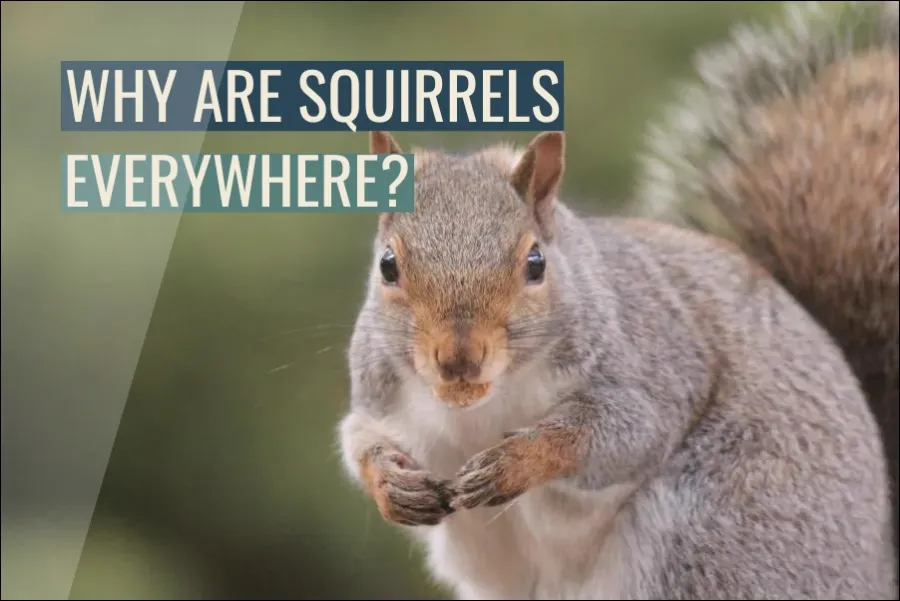
Have you noticed an increase in squirrels in your neighborhood or local park? You’re not alone – squirrels are found all over the world and are considered a common sight in many areas.
Squirrels are found worldwide due to their adaptability and successful reproduction. They can thrive in many habitats and have evolved adaptations to suit local conditions. There are over 280 species of squirrels on every continent except Antarctica.
From city parks to suburban backyards, squirrels are a familiar sight for many people. But where do these furry critters come from, and why are they so prevalent?
Where do squirrels live?
Forests, meadows, and even urban settings are all suitable homes for squirrels. Squirrels are present on every continent but Antarctica, and there are more than 280 different species. The Eastern gray squirrel, the fox squirrel, and the red squirrel are all common squirrels found in North America. The Eurasian red squirrel is widely distributed throughout Europe. There are several species of squirrels that have adapted to life in other areas of the world, including Asia and South America.
How do squirrels adapt to different environments?
Squirrels are extremely versatile creatures that can survive in a wide variety of ecosystems. They’ve gotten rather good at adapting to new environments by this point, both physically and behaviorally. Some squirrel species, for instance, are better suited to colder temperatures because of their thicker fur coats, while others are better suited to warmer climes because of their lighter hair. Squirrels, like humans, may adapt their diets to the foods that are readily available in their surroundings. For instance, squirrels in cities may rely more on human foods like seeds and nuts, whereas in the wild, they may eat a larger range of plant materials and insects.
What do squirrels eat?
Squirrels are classified as omnivores since their diet includes both plant and animal stuff. Squirrels’ diets in the wild consist of a wide range of plant and animal matter, from seeds and nuts to fruits and fungus to insects. Squirrels in urban areas may also consume bread, crackers, and birdseed. An acute sense of smell helps squirrels find food reliably and quickly. They can hide food away or bury it for later use.
How do squirrels reproduce and raise their young?
Based on the species and environment, squirrels can have a litter at any time of the year. Most squirrel species only have one mating season each year; however, their young are born twice. Typically, a mother squirrel may have anything from two to eight babies, which are referred to as kits or cubs. Mother squirrels typically raise their young for eight to sixteen weeks before sending them out into the world on their own.
What are the biggest threats to squirrels?
Predators, illness, and the loss of habitat are just some of the dangers that squirrels confront in the wild. Common squirrel predators include larger animals like foxes and snakes, as well as birds of prey like hawks and owls. Diseases like rabies and Lyme disease may be spread through animal bites, putting squirrels in danger of infection. The loss of forest and field habitats, as well as other natural areas, is a serious problem for squirrels because of urbanization and other types of land development. Because climate change may affect the range of squirrel species as well as the availability of food and other resources, it may constitute a hazard to the animals.
Is it good to have squirrels around?
Whether or not squirrels are beneficial to have in an area depends on a number of things, such as individual opinion and the nature of the area. Squirrels can be seen by some as a nuisance, while others may find them interesting to watch. When weighing the benefits and drawbacks of squirrels, keep in mind the following:
Pros:
- People that take pleasure in observing animals may find squirrels to be particularly entertaining. They are usually lively and full of life, making them entertaining to watch as they go about their day.
- Squirrels support the environment in many ways, including seed dispersal and flower pollination. The Eastern gray squirrel is one species of squirrel notable for its habit of burying food, including seeds and nuts, which can aid in the revitalization of forests and other ecosystems.
- Insect pests like aphids, mites, and grubs can be kept under check by squirrels, as they are known to devour these pests.
Cons:
- Squirrels are known to gnaw on electricity lines and destroy landscaping and gardens. Another source of irritation is when they break into bird feeders or steal from barbecues.
- Rabies and Lyme disease are two of the many diseases that squirrels may spread to people. Although the likelihood of catching a disease from a squirrel is minimal, it is always prudent to exercise caution with wild animals.
- When squirrel populations become too large, they can start wreaking havoc on locals and the environment. If squirrels, for instance, multiply at an unsustainable rate, their increased numbers might harm other animals by driving up prices of essentials like food and housing.
Whether or whether squirrels are a net positive for the ecosystem and human activities depends on the specifics of the situation. Squirrel population management, including catching and removing squirrels or altering squirrel habitat, may be necessary to solve certain problems. The option to cohabit with squirrels and take measures to lessen their potentially harmful effects may be preferable in some contexts.
In Conclusion
Squirrels are widely distributed around the globe, and they may be spotted in a wide range of environments, from forested regions to open fields to metropolitan centers. There are more than 280 different species of squirrels, and each one has adapted in some way to its particular environment. Squirrels are omnivores, meaning they consume both plant and animal material, such as seeds, nuts, fruits, fungi, and insects. They have litters of anywhere from two to eight young and can have babies at any time of the year, depending on the species and the temperature. Predators, diseases, habitat loss, and changing weather patterns are just some of the dangers that squirrels encounter in the wild.
